Text
Jerstin Crosby / Character Flaws David Colagiovani / Live Guitar
Perambulation within 'Character Flaws' - paintings by Jerstin Crosby at the Horace Williams House - Closing reception June 29, 2025, Chapel Hill, North Carolina. Loosely gridded composites of being - evolving Crosby's ongoing preoccupation with "the face" in minimalist, reductive and often absurdist terms, now merging into amalgamations of architectural space, banal signifiers of daily life (power strips, a tea bag, lamps, speakers) punctuated by disembodied body parts and yes more faces. The show includes a single sculptural work in the form of a boom box constructed in stained glass. Live electric guitar performed by by David Colagiovani. This video features a piece Colagiovani said he would play for me - not sure if he was just making it up on the spot or he was playing something he'd already composed. I was listening, feeling it. It was lush, rolling, warm, trance-inducing. I clicked 'record'. At first it's only walking around, only feet, legs and floor, but some work is shown toward the end. Jerstin is fleetingly visible, and someone chimes in with some la la la right before the video stops.
youtube
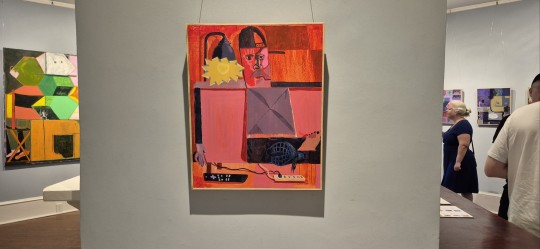



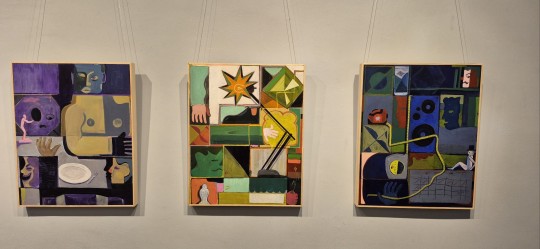
1 note
·
View note
Text
Like a Fog Holds the Light - Conner Calhoun - Lump Gallery
Jotted gallery notes (in bold) expanded upon herewith.
Tweaking my world. My nervous system registered immediate impact upon entering Lump Gallery in Raleigh, North Carolina, United States of America, Planet Earth, to see to see Conner Calhoun's exhibition Like a Fog Holds the Light. (Reference is made here to specificity of place, emplacement, displacement, transitional contexts experienced in transit and in transition from one site/state/mode to another as salient harbinger of the show's thematic tendencies.) It was a Saturday. My friend Laura drove us. Upon entry into the gallery space I was tweaked, energized, agitated, drawn in. Yet there was nothing loud about the work. The registered impact was of its own order (not hitting but nevertheless expansively projecting). This would be work that exacted specific requirements in its encounter: somatic awareness, cognitive capacity and clairvoyant potentialities on high alert. First impression - nothing obvious, literal or telegraphed. Rather, the work appeared to be oblique, metaphoric and encoded-verging-on-subliminal. The main gallery space was filled with large, largely dark paintings and a few mysterious sculptural constructs on pedestals. Object No. 1 (Ablaze) was a small bisque ceramic house filled with Slim Jim meat sticks (within a vitrine might I add. What is implied by the purported offering of a meat snack denied to the desirous snacker by a plexi barrier? What are the meat implications? The oral implications? The survival implications? The road trip implications? The gendered, body implications ["Jim"? "Slim"?]? And consider the fire implications, both literal and symbolic, implied by the work's title Ablaze.). Object No. 2 (Flower) was a spray can with an oddball sculptural flower attached to and emerging out of the spray nozzle (this trope of insertion, interconnection, diagrammatic interrelations among ostensibly separate elements would be a thematic aspect iterated throughout the show).
[My perception of the] Outlets & infrastructure of the space - altered. As I began to absorb Calhoun's paintings, they began to absorb me. The Chest in Movement (oil on canvas) is a windswept surrealist scenario in which a cartoonish figure of a person wrought in cold gray tones with yellow ovals for eyes stands before a rounded wood table on which is a large open book and a vase with stylized blackish flowers blown by a harsh wind that sweeps through the composition - the windblown flowers cut across the center of the canvas and extend both in front of and behind the person, whose monotone gray hair and beard flow in the same direction (right to left). The vase is superflat, 2D, while simultaneously signaling dimensionality, shaded right to left from muddy yellow to greenish-yellow to black, which both sets it apart from the rest of the pictorial elements - almost as if it has been grafted onto the scene - and anchors the composition. The person's hand slides under the book but inexplicably / miraculously / mystically also casts a long light gray shadow upon its pages, which are open to reveal the Roman numeral "LXXIV" ("74" [the year of someone's birth?]) and the titular phrase "The Chest in Movement" on one side and mysterious diagrammatic illustrations on the other. And what of "a chest in movement"? The phrase holds the potential for both the erotic and the quotidian (throes of ecstasy or simply a body moving through space). But unlike some artwork titles, there is no punning here, no "ah-ha" moment. Calhoun chooses to sustain the mystery rather than offer overt clues. The imaginary landscape behind the painting's protagonist is snowy and white and extends back toward a range of blue and white snow-covered mountains under a flaming yellow-into-orange sunset. The experience of viewing this and many of Calhoun's other paintings is that of encountering a portal to another dimension. I had the sense of beholding, and at times being transported directly into, an alternate mode of being [which left me simultaneously still being myself while also inhabiting aka holding a wholly other mode of reality]. Thus, as I moved through the gallery space, everything became activated and merged into the world perpetuated by the work. I thus experienced something akin to shock in encountering electrical cords, exposed corners, outlets (the actual gallery infrastructure) - all of which had become imbued with encrypted meanings.
Heart rate up not due to overt erotics [which were there] but to overall sense of intention. My somatic response to this show was providing an onslaught of information. Overwhelmed as I was by the impact of the main gallery space [which included aforementioned erotics (a painting titled Took it too far features a face down person with splayed legs and a fantasized black anus-as-crevasse cracking open as if at the epicenter of an earthquake with a mystical thread opening out into a trumpet-like figuration out of which emits something like an unscrolling musical score)], I transitioned into the adjacent gallery space just to get my bearings. There was more work by Calhoun, of a similar world-bending order. It was at this point that I made a mental note and jotted down that my heart was indeed pounding. There were a few casually placed objects on the floor. These included bisque ceramic vessel forms (Imposters and is that a bong?) and three materially compelling ceramic "cans" spray painted a believable metallic silver. They were a bit outsized and kind of wonky, as if they'd been kicked or a bit crushed - and they conveyed a peculiar banality but nevertheless sustained an aura of mystery and gravitas. I am not entirely sure why or how that sense was achieved given the Oldenburg-like goofiness of the presence of the fat, lolling cans. But I feel as though my sense of the cosmic crashing into the quotidian was not merely idiosyncratic as the title of that work, Star Cluster, suggests a similar understanding by the artist.
Parallel/Alternate Universe. Spliced Realities. It was the painting titled i have felt this before / erofeb siht tlef evah i (a title that cleverly "mirrors" the idea of perceptual inversion and/or deja vu) that triggered these notes. The composition of i have felt this... is roughly divided into one third of the left and two thirds of the right side of this large painting. The color palette of the work is conscribed to blacks, grays, whites and various degrees of saturation of (what reads as) phthalo blue. The pictorial plane is bisected by the black line of a wall's edge in a dark room in which a person holds up a lantern toward the wall, with an expanding vector of light illuminating a circle on the wall. On the other side of the wall in a blue room is an entirely distorted figure facing the wall, instead of a lantern, light emanates out of the figure's gaping maw and meets the light on the other side of the wall. Both scenarios include a ladder, a long hanging light fixture and a bench with a paint can, parallel imagery but not precisely mirrored in terms of placement. Another utterly cryptic aspect is how each figure extends a leg in a manner beyond anything humanly possible, as if the limbs were elastic material projected from the body and twisted such that the sole of each foot with bent supporting toes faces the viewer. We can infer the idea of an artist within their studio. The idea of facing a wall. Of shining light. But from there we are cut loose with our own sensations and understandings. The "parallel universe" and "spliced realities" suggested by my original jotted notes are mirrored by the impossibility of ever fully entering or knowing the hermetic meanings, the world apart, of this work.
Mug paintings x 2. [This note addressed the image of a ceramic mug, which was the focal subject of two outlier paintings in the show ("outlier" due to their relative lack of complexity) - simple object studies. It should be noted, however, that the presence of mugs can be found throughout many of the works in the exhibition, functioning as a form of punctuation, pointing to something domestic or habitual or basic within otherwise other-worldly contexts. The recapitulation of the mug imagery also had the uncanny effect of suggesting a roaming presence within and among the paintings.]
Vectors (matte/shine). I came to think about the works in the show in terms of vectors of meaning. I also noticed subtle painterly differentiations of areas of matte and shine finishes.
Philip Guston / Giorgio Morandi / David Salle / Peter Saul / Henri Matisse These are some of the painters whose work came to mind as I considered Calhoun's painting style. These names should not be construed by the reader as containing or limiting what Calhoun is doing in this work. They are simply top-of-mind jottings relative to momentary spatial perceptual observations that emerged in the encounter with it.

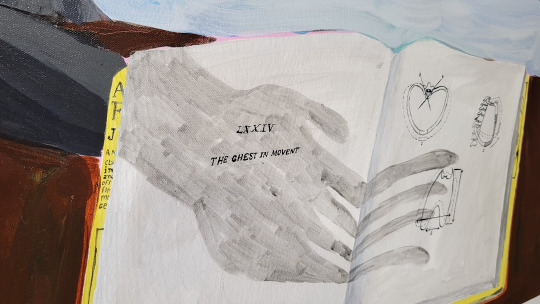
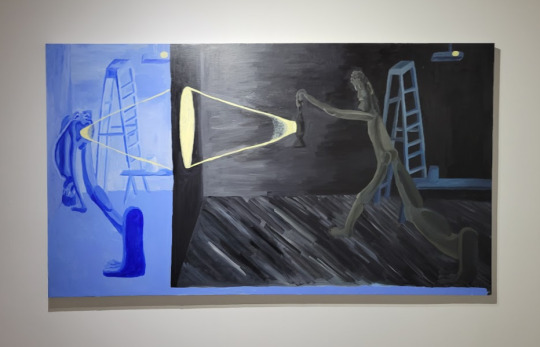
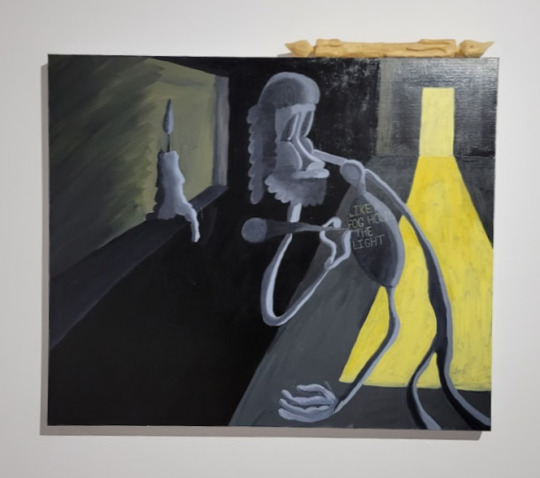
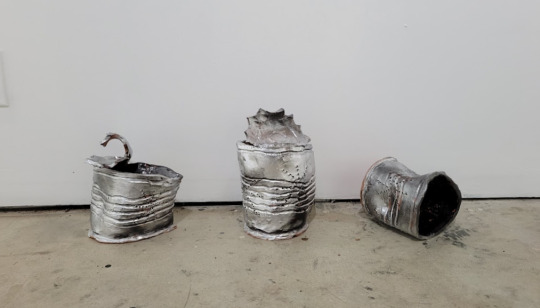
1 note
·
View note
Text
Weaving at Black Mountain College
When weaving is more than weaving.
I hadn’t anticipated the sense of awe and quietude that overcame me upon entering the exhibition space at the architecturally elegant Black Mountain Museum + Arts Center to view Weaving at Black Mountain College: Anni Albers, Trude Guermonprez, and Their Students, curated by Julie Thomson and Michael Beggs. This was a case of the vast, infinite distance that lies between experiencing the image of a thing and experiencing the thing itself.
Walter Benjamin wrote about the aura of the handmade object, and the weavings of Anni Albers, Trude Guermonprez and their students are case studies of same.
To stand before these works was to bear witness to a particular mode of being. The feeling was palpable. They radiated an alternate temporality and mindset of care, precision, and that particular mode of open, active inquiry that has come to be associated with Black Mountain. They held the space as minimalist, even conceptual (certainly performative [in the J. L. Austin sense]), abstractions of the highest order.
I hadn’t anticipated how much the works would feel like art. The art vs. craft question has roiled for so long – but the fact that the work presented in this exhibition shared indexical space with county fairs and hobbyists only underscored their elevated state. A productive tension.
Also productive might be to think about the work produced in Black Mountain at that particular time (mid-1940s) by those particular artists in relation to the feminist artists’ embrace of craft in the 70s (a world apart) and, later, Mike Kelley’s appropriation of same. Inherent in Kelley’s More Love Hours Than Can Ever Be Repaid and The Wages of Sin is the question of transactional exchange, from which might be extrapolated the possibility of a microcosm whereby the forces of capitalism are grafted onto love expectations within familial systems. In contrast, the works on view in Weaving at Black Mountain College suggest a suspension of such conditional terms of value. They speak to a lifting of temporal imperative, to the joy attained through focused effort toward deeper understanding, its own adventure, pursued as a value in itself. The aesthetic pleasure in beholding the beauty of the resultant objects feels nearly secondary to the infinite levels of learning and life-changing experience of living and being at Black Mountain. This is not to diminish the profundity of these works. I will never forget having been able to witness them in person. I feel them with me still.
Anni’s works were especially revelatory for me in their refinement, clarity of vision, complexity and depth. An untitled weaving from 1949 in rusty orange tones, wheat yellows, ash grays and coal blacks drew me into systems of logic that were established and then subtly not repeated, a grid-like configuration in which long rectangular forms recurred but emerged in some units with angled sides rather than the expected straight upright edges. This foiled logic system signaled to the viewer that nothing in the work was to be taken for granted, that every stitch, every module, had something to offer. Like all great works of art, it felt like one could spend a lifetime in relation to it, ever-exploring and encountering subtleties, shifts, new ways of seeing and thinking about the work itself and more broadly about weaving as a practice, an idea, a mode of being in the world.

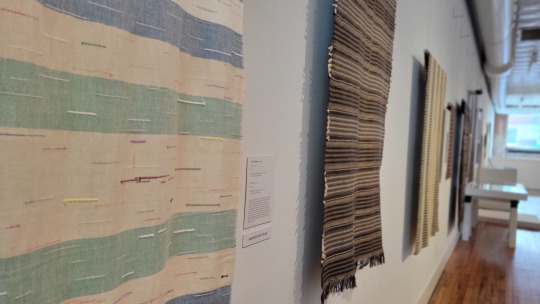
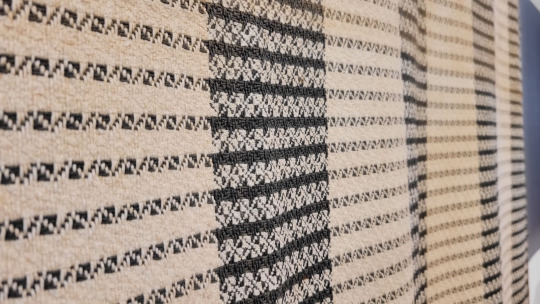


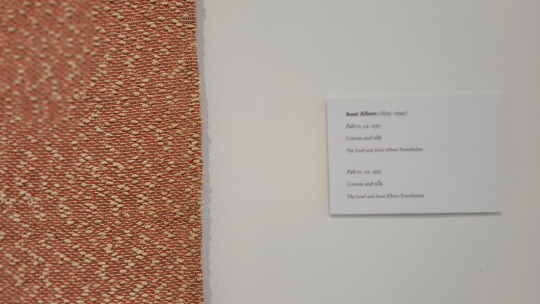


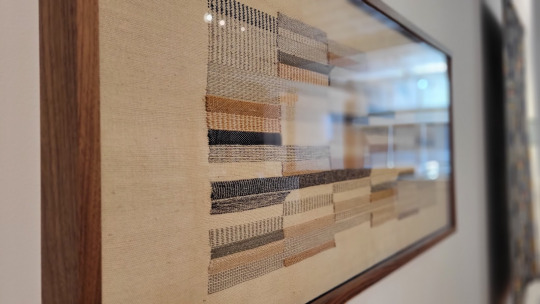
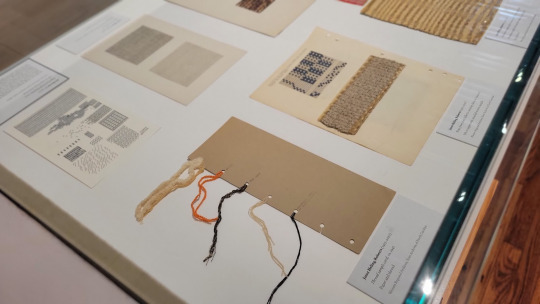
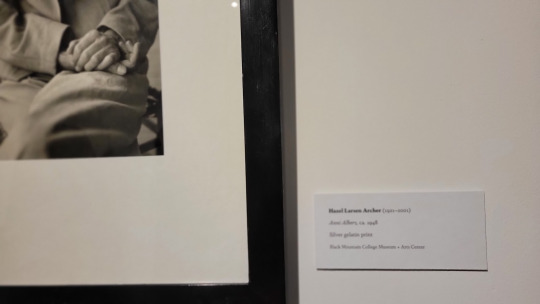


5 notes
·
View notes
Text
Bluebeard's Castle / a novel by Anna Biller

I first encountered polymath auteur/cinéaste Anna Biller when she screened her Cal Arts thesis film Three Examples of Myself as a Queen (1994) at Beyond Baroque Literary/Arts Center in Venice, California. The film was a tour-de-force - a straight-faced hilarious surreal camp fantasy musical that Biller wrote, starred in, directed, costumed, composed and set-designed. Around that time I was also lucky enough to catch her live stage production, The Lady Cat, in which she starred as a be-whiskered furred sexy feline. Those glorious offerings have since been followed by films such as The Hypnotist (2001), A Visit from the Incubus (2001), Viva (2007) and The Love Witch (2016), each of which has been a gleaming iconic/iconoclastic constellation in the Anna Biller firmament.
Now, years later, I've just finished the audio version of Biller's debut novel, Bluebeard's Castle (Verso Fiction, 2023). Fascinating, complex and interwoven with stealth historic, cinematic and literary hat-tips, the novel absolutely felt like an Anna Biller production. Biller's indelible mise en scène over the years has been so gloriously signature with its unapologetic embrace of nostalgic high fashion and cinematic kitsch that the novel unspooled in my head as a dazzling film punctuated by bits of quintessential Biller-esque theatrical side-business: naked men painted white posing as statues; costumed dancers performing a sensual pas-de-deux between a caterpillar and a butterfly.
The book is a true-to-form romance novel that follows the erotic evolution of romance novelist Judith as she is drawn ever deeper into the gravitational pull of a devilishly handsome cad. But Biller subverts the genre by confronting the reader with the nightmarish horror of the narcissistic demonic, all the while seducing us with inescapable eroticism, daring us not to turn the page (or keep listening to the audio - convincingly read with Gothic intensity by Samantha Hydeson).
The juxtaposition of romance novel genre and rigorous razor-sharp psychological insight of Bluebeard's Castle made my head spin. In vivid Biller-esque fashion, the dark momentum of the work made me feel like I was being strangled with a gold satin cord and lowered into a red velvet lined coffin in a symbolic death. This is a filmmaker's novel with big dreamlike technicolor impact and Hitchcock-like precision.
I read somewhere that Biller had originally pitched Bluebeard's Castle as a film and, rather than wait for the capricious wheels of cinematic fate to spin in her favor, took to the novel form and made it happen.
Here's holding out hope that this scintillating work gets a green light. Would be epic.
19 notes
·
View notes
Text
Tama Hochbaum / As if a Mirror
Tama Hochbaum / As if a Mirror / Horace Williams House
“…the house furnishes us dispersed images and a body of images at the same time.” – Gaston Bachelard, “The Poetics of Space” (Maria Jolas, Trans.) (1964)
In Tama Hochbaum’s “As if a Mirror”[*] at Horace Williams House in Chapel Hill, composite digital self-portraits invert Bachelard’s invocation of the house-as-site-of-poetic-space and furnish *images of bodies* [one single body and one single visage, those of the artist] arrived at through a coalescence of *dispersed images* presented within (and occasionally reflecting imagery derived from) a home that has been preserved as a historic site.
Digital fluency: Represented here is an art practice that has evolved from painting to photography to digital photography, and from composite digital imagery to multidimensional digital imagery, manifested in multiplicities of images that coalesce in intricate logic systems of mandala-like complexity and a seemingly infinitely fine-tuned spectral awareness of color. The compositions circulate around a central self but defy the [spatial/temporal] stasis inherent in the self-portrait concept – the idea of a person “captured in time.” Instead, they explode into galaxies of simultaneous being featuring an array of architectural elements, wallpaper, views of gallery openings, shadows, figures of other people and textural interior surfaces – cosmologies of lived [temporal/spatial] experience.
Intermittent early painted self-portraits bookend the works on view. At first I was ambivalent about the inclusion of the paintings in the show and wondered if they drew focus away from the main body of work - whether they functioned as archival footnotes rather than focal work. But they do provide material contrast. They underscore and implode differences not merely in time between the artist in her twenties and the artist now celebrating her 70th year and evidence an enduring life in art but more directly speak to expressive variations between the two mediums and facilitate real-time thinking-through and comparison about how the different modes of display function. The contrast inevitably delivers us into The Now and tells us something about the fabric of lived existence within the technological framework of cellphones, social media and image saturation.
If you spend a lot of time in a place, does *it* change *you*? Do *you* change *it*? Hochbaum has spent countless hours at Horace Williams House as a curator of the space’s contemporary art program – the other day she referred to it as “her second home.” Thus there is something uncanny about the visual recapitulation of the artist as composite self throughout the space in these works, which are peppered with architectural details of the historic site. It’s the opposite of haunting – it’s more like an infusion of amped vitality and presence. The works speak to a condition of absorptive/reflective existence – whereby all life around one is subsumed within – so that one becomes both reflection and embodiment – world poured into the self / self radiating the world – a condition encapsulated in works of painterly perspicacity that remind us of something true about ourselves [and not just the artist] that we may not [yet] have been able to see - about the multitudes we contain and how we contain them.
[*] Which I also read as (1) As a mirror. (2) If a mirror. (3) If/then a mirror.
As if a Mirror illuminates the human/spatial interface of mediated life.
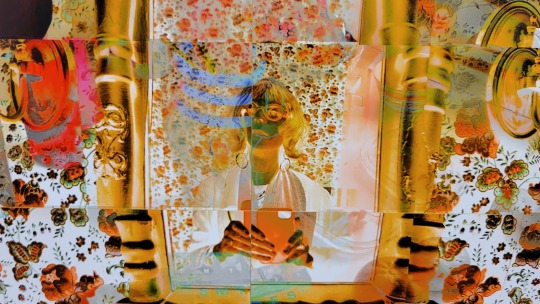
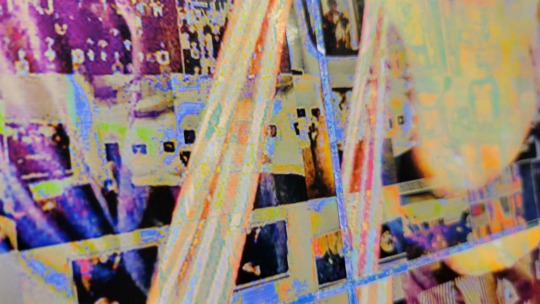

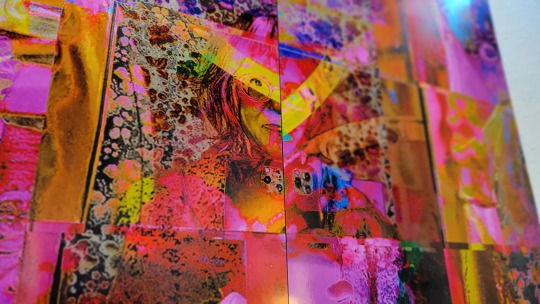



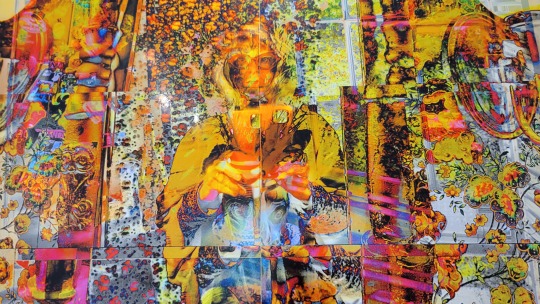
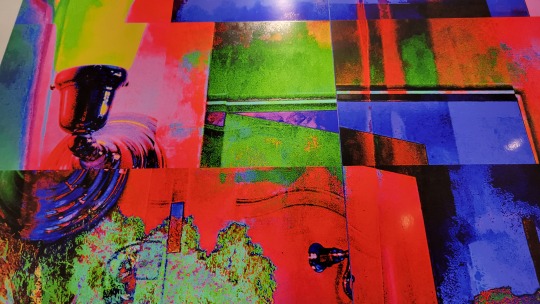
All photos above details of Tama Hochbaum, "As if a Mirror," Horace Williams House (2023) shot by author.
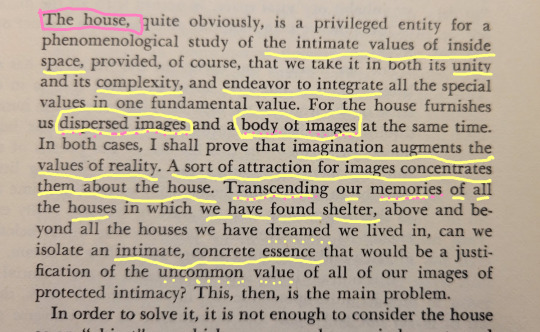
[From Gaston Bachelard, "The Poetics of Space" (1964) underlined by author]
0 notes
Text
#Slump #Lump
Slump at Lump Gallery / Curated by Jerstin Crosby based on conversations with New York-based artist and LabSpace gallery co-director Julie Torres
SLUMP. Some words do more heavy lifting than others, and I am rather in awe of the sheer tonnage this single-word title manages to bench-press, with meanings that cover "slack," "flaccid," "weak", "defeated," "pathetic," "depressed," "low ebb," and "doldrums" not to mention "bad posture" and "a period of time marked by failure."* This is a show that registers high on the coherence-of-curatorial-intention meter. A show with this title could have ended up as a zone of airless claustrophobic overwhelm, gallery as hoarder space, due to the sheer surfeit of potential work that could have been slotted within the “Slump” rubric. Instead the show is edited with drum-tight precision, each work positioned in the space for maximum flow and impact. This is a show that breathes. Good feng shui. It’s thus paradoxical: a show called "Slump" that is in itself highly articulated - crisp, concise, highly engaged and engaging. Go figure.
An overall note on influence: Mike Kelley's splayed societal/ cultural/ subliminal abjections have inoculated the bloodstream of the body politic of contemporary art, a tribute to the necessary-ness of that artist’s efforts, the validity of which is evidenced by the spectral array of vital and meaningful work that has been made and likely will continue to be made in its wake: artist as shiner-of-light on psychic detritus that has been relegated to the societal dust heap due to collective denial, blindness, greed or best practices. It is thus no surprise that much of the physical [and nonphysical for that matter] material employed in Slump is multiplex and often recycled, repurposed or reconsidered.
Raymond Padrón’s revelatory “Tube Sock” (2023), while made of painted wood (and not literal recycled material), embodies “that which has been lost or discarded.” The single sock that evades capture holds near-mythical status in the unwritten history of laundry. The highly visible tube sock reclining on someone’s floor is another well-known trope. I will add that while “Tube Sock” in its supremely casual and might I add believable pose [why not anthropomorphize a sock?] (as for said pose, I buy its slump-ness, its nonchalance, its actual real-life tossed-ness – it’s a sculptural tour-de-force) as Padrón has rendered it appears clean enough, I cannot stop the onslaught of sock associations, which include dirt and smell. This sensory response to a monumental relief work aggrandizing a single item of bit-player clothing is a win.
Another win: the placement of “Tube Sock” adjacent to Julia Gartrell’s indelible sculptural work “Rib” [undated]. These two works by two artists working within their own bubble of slumpness manage to converge in uncannily similar shaping and sense of weight distribution. “Rib” is a work that manages to immediately attach to the mind like a parasite. I mean this admiringly. Like “Tube Sock,” it is both hilarious and beautiful, surreal and gritty, utterly evident in what it is and yet also deeply mysterious. The premise of “Rib” is simple: a single boot [(the artist’s boot) that carries questions about and signals a uselessness similar to Padrón’s single sock] with a Ruth Asawa-esque reed basketry leg figuration that sort of floats off into nothingness – no body – tethered to no world in particular, to sudden, unexpected abstraction.
Bill Thelen's untitled limp wrist project covers much of the Drawing Room annex wall. These are interactive drawings based on photos people sent to the artist in response to his request for shots of their limp wrists. The project is a canny power move by Thelen – up there with the reclaiming of the term queer in the 80s. The visual reclaiming of body-language cliché epithet celebrates and recalibrates what has historically functioned as a denigrating trope of [specifically gay, male] flamboyance** by creating what feels like a solidarity wall papered over with drawing upon drawing of images of limp wrists en repose, i.e., held aloft, hand and fingers relinquished downward to gravitational pull. The works are not gender-coded, and they’re not color coded; they’re disencoded.*** There is an expanded iteration of the project as part of the exhibition proper, a single outsized limp wrist outlined in relief with woven embroidery floss, tape and pins.
I could write in-depth on each of the works in this substantial and generous show, which was appropriately allowed to inhabit both gallery rooms. But given that it’s the last day of the show and would be nice to post it with at least a few hours left – and in light of inherent limitations of the person writing this – will list the artists here:
Amanda Barr
April Childers
Bill Thelen
Brandon Boan
Celia Gray
Conner Calhoun
Ellen Letcher
Fred Smith
Jasmine Best
Jessica Langley
Julia Gartrell
Julie Torres
Maria Britton
Nico Smith
Rachel Bernstein
Raymond Padron
Skully Gustafson
Terry Hoff
Tonya Solley Thornton
A few final thoughts: As in the conundrumical universe of curatorial practice, every piece in this show held the potential to live within infinite other parallel universes of thought. The “Slump” mindset, however, focuses the mind like hunger – or a strong need one did not know held sway within until it was met. The clarity of intention in this show was so strong it felt like I was walking around the space wearing one of those museum guided-tour headsets.
Can I just add: Slump also works as a riff on the gallery name: Lump. I read this as a kind of evolutionary equation whereby Lump [L] = Lumpen/Unformed ∆ Lump + S/ = S/lump = Slump [SL]
And another thing: A slump is a temporary condition. That will at some point turn around. Hence it posits an undercurrent of hope. With the evolutionary outcome not being verticality or a *straightening* [aka devolving / attaining regressive rigidity] but some mode of as-yet unidentified [fluid] expansion.
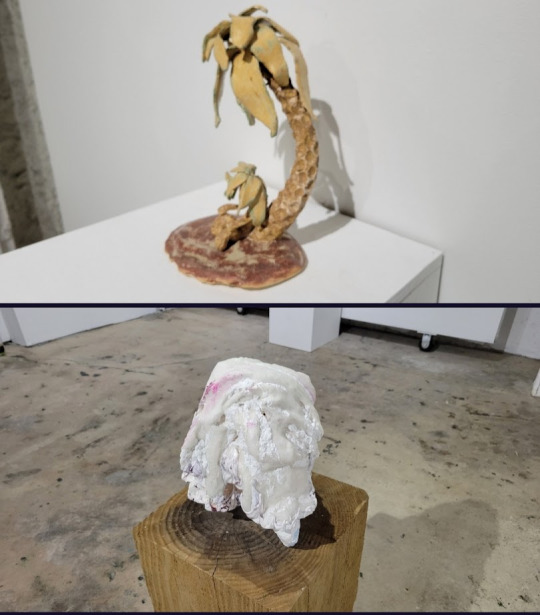
April Childers / Brandon Boan
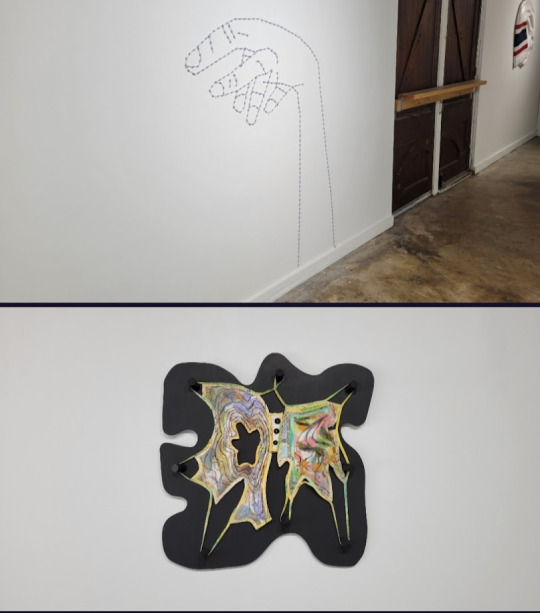
Bill Thelen / Maria Britton
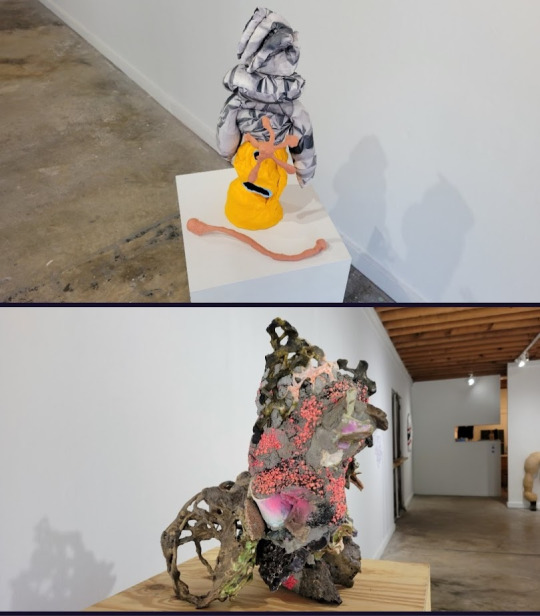
Amanda Barr / Celia Gray
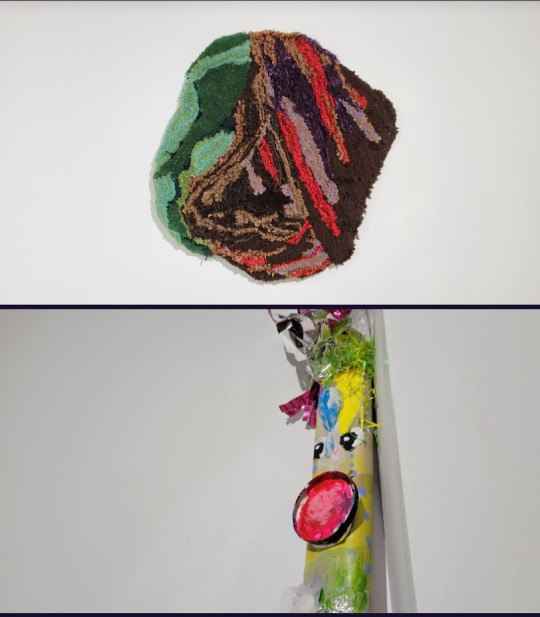
Jasmine Best / Skully Gustafson

Tonya Solley Thornton / Tonya Solley Thornton

Ellen Letcher / Lump Gallery (installation view)
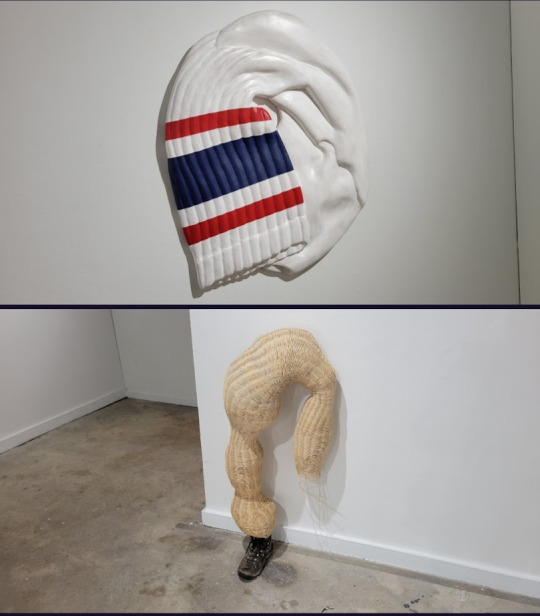
Raymond Padrón / Julia Gartrell
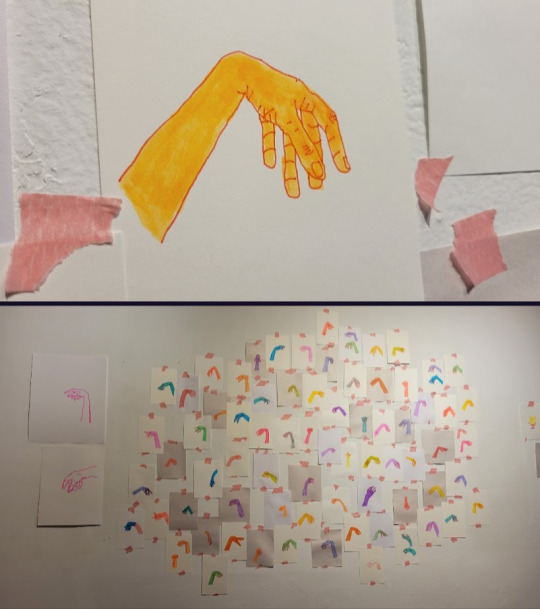
Bill Thelen / Bill Thelen [Drawing Room]

Skully Gustafson / Skully Gustafson

Fred Smith / Fred Smith
___________
* I typically write about work before reading gallery copy and have only just now encountered a list of related salient adjectives supplied by Crosby, which are available elsewhere. However, the fact that there are few overlapping terms in the two lists underscores the fertile elasticity of the premise.
** A word that pings in my head thusly: [flimsy/ flim-flam/ flambé/ flaming/ boy/ buoyancy/ bouyance/ clairvoyance/ (disco ball) dance].
*** My text my rules yes I just made up that word.
3 notes
·
View notes
Text
#doublepang #souvenir
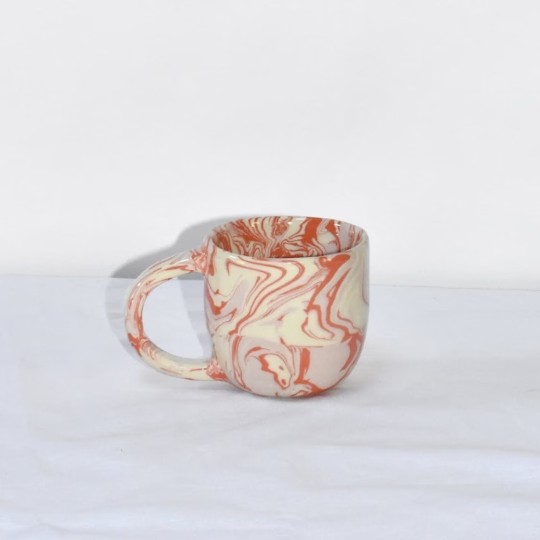
When a thing elicits desire to the point of actual ache. Dwell article describing a personal collection of ceramic pieces acquired in various countries induces double pang of desire for world travel and ceramic object acquisition. Each ceramic unit tethers memory to the precise locus of acquisition. Literal earthen material extracted from the spot under one's feet. Souvenirs from the ground. The ceramic souvenir is an intensity. It consolidates time, place, being and memory. The term 'clay body' is not random. It reveals and reinforces an unconscious affinity.
2 notes
·
View notes
Text
#sun #paparazzi #exposure
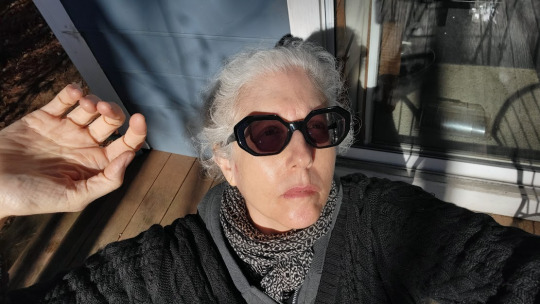
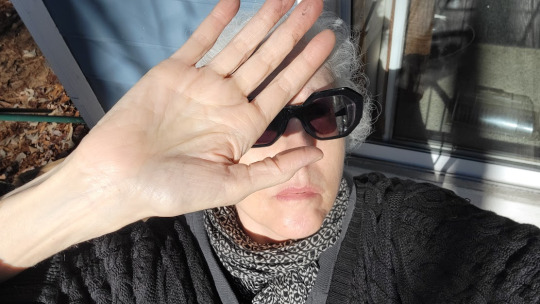
In which the author is captured [by herself] via [digital] image while engaging with the glare of the sun as if it were a swarm of paparazzi. Note the parallels between the sun’s rays and the question of exposure by swarms of photogs seeking to grab images of celebrities when they are out and in public and in the public eye for the purpose of vast dissemination and visual consumption by a public with an insatiable visual appetite. Sunlight is a means of exposure as illuminated in the cyanotypes, photograms and radiation captures of the artwork of elin o’Hara slavick. Here the author self-exposes to the sun and yet in the moment of the pictorial snap seeks to block the [surveillant] glare [gaze of the camera eye]. The cliche of exposure-seeking famous person is embodied by sun-seeking layperson. Self as solo paparazzo seeking to aggressively grab [document/ immortalize/ crystallize] this moment in the sun and later expose self-same self [selfie] via Tumblr.
#sun#paparrazi#photography#self#selfie#exposure#surveillance#immortal#fame#celebrity#cliche#Parallel Structure#immortality
1 note
·
View note
Text
Doubling down on mineral implications
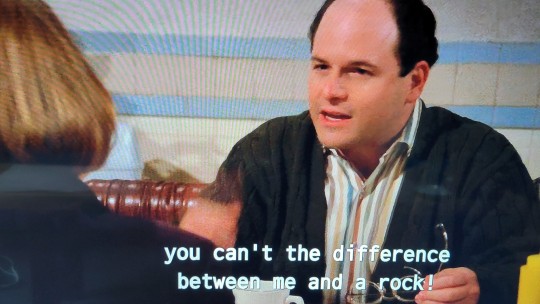
2 notes
·
View notes
Text
#bones #thinking
Sculptural dynamism. Recognition of interior scaffolding. I arise via skeletal authority. The skeleton is the author of my verticality. Smooth motion is underpinned by stable architectures. Interface with ground and gravitational forces. Shared modes of alignment among living mammals. [In response to today's offering from @biodiversitypix. [“Description of the skeleton of an extinct gigantic Sloth, Mylodon robustus, Owen, with observations on Megatherioid quadrupeds in general /.London, 1842″ ]

1 note
·
View note
Text
#bellhooks #absorption

Allowing absorption to occur. Vogue magazine and Artforum archive online on laptop interflowing bell hooks on Lorna Simpson's The Waterbearer contiguous with image of model submerged in H2O adorned with fluid silver and sheer honeyed chiffon - the turquoise water intermerging with here/now situated material time/space of self bearing witness under tonally and uncannily congruent turquoise cotton quilt. Those of you familiar with the Tarot you may recognize something about the imagery (illustrated enduringly by Pamela Colman Smith) that can be associated with the Major Arcana card representing The Star - about which I had years ago generated a nametype arising out of internal subjective identification with said card via among other things the astrological aspect of my tropical star sign of Cancer - which is also a water sign (the nametype: "poursaint") - this spontaneous elemental interface allowing me to flow toward modes beyond the limits of the dominating constructs of the world into which I was born under that selfsame starsign. All continues to flow always."The water flows like a blessing. Despite changes, distortions, misinformation symbolized by its containers, it will continue to sustain and nurture life. It will redeem. It is the water that allows the black woman figure to reclaim a place in history, to connect with ancestors past and present." - bell hooks
#bellhooks #lornasimpson #vogue #tarot #artforum #artforummagazine #pamelacolmansmith #pamelacolmansmithtarot
0 notes
Text
#dinosaur #crystals
Dinosaur eggs the size of bowling balls - of a heretofore unknown oospecies of dinosaur (Shixingoolithus qianshanensis) - have been found in China (Upper Cretaceous Chishan Formation in the Qianshan Basin, Anhui Province, East China). The ancient eggs are filled with calcite crystals. Resonance of egg - symbol of future life - filled with crystals - precursors of future life. Highly consonant [as opposed to dissonant] - glimmering revelation of unknown oospecies via enclosed egg - life indicator - and crystals - mineral accretions.

.
8 notes
·
View notes
Text
#Augustus #Sera

For the record, it is not lost on me that the concentric configuration of the Mausoleum of Augustus shares some striking parallels with the monumental works of Richard Sera.
#AugustusMausoleum#mausoleum#augustus#mausoleumofaugustus#sera#richardsera#concentric#mortality#architecture#architectural#spatial
0 notes
Text
#paint #RachelCampbell #gorge #gorgeous
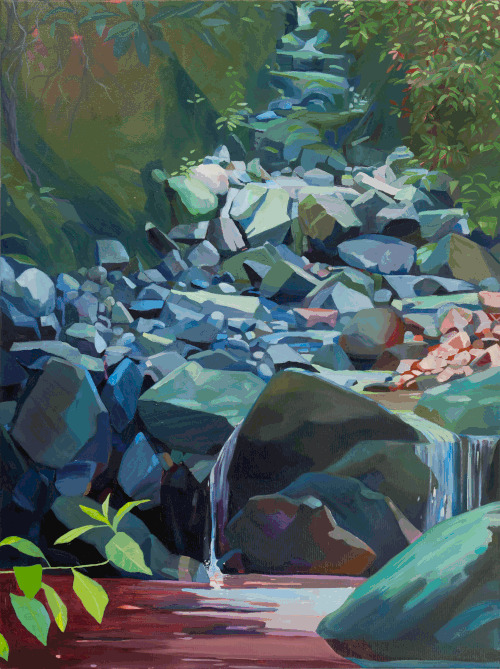
Rachel Campbell, Another Summer II (2021), oil on canvas
Have been following Campbell’s work for a while and it continues to evolve in ways that continue to surprise and delight me. I am more familiar with her domestic blissed-out trailer homes, potted plants, sundry interior elements and bold yet sensitive Wayne Thiebaud-esque works. To be clear, there is nothing glib or simplistic about invoking Thiebaud here. Thiebaud is an excellent painter and so is Campbell. They share the capacity for visual precision without sacrificing painterly joie - a sense of the celebratory coupled with a sense of humor (which as time goes on feels increasingly like an essential component of truly great work). I think the term “delighted” is apt in describing Campbell’s work: her pictures are infused with deftly handled lights and darks - her palette is as delicious as any dessert Thiebaud ever served up. Here Campbell captures something true about the earth and dirt and plant life and lush mosses and rushing water and gravity and physics and how geologies are always plural and active - the painting provides access to the histories of that particular geographical site with the fullness of its natural beauty and how those gorgeous blue/gray/green/pink & brick-red boulders once carved out that spectacular gorge.
2 notes
·
View notes
Text
#beige

2 notes
·
View notes
Text
#Western #Redux #LouisWatts “Hey, Cowboy” (2021)

Bullet Points: Louis Watts, “Hey Cowboy” (2021) From Amy White, purveyor of mighty fine textual analyses at risk of overthinking all things pretty much all the time
* Curvaceous 70s font / Italicized version of font used on Erica Jong’s “Fear of Flying” (1973)
* Homo-erotics or Hetero-erotics of the term “Hey, Cowboy”**
** One supposes the “boy” in the term “Cowboy” by definition precludes references to Non-Binary-erotics, then again, perhaps that’s the point - the pointedness, the forcing the issue of, the hammering home of the clichéd iconography as a means of exposing, undermining - rather than reinscribing - extant binaries - it is a fine line
* Watts’ clean-shaved face - based on his face alone central casting would likely be calling him back for past/future cowboy roles
* What is it like to look in the mirror every morning and confront that face [the work confronts us with that face - the work also to some extent functions as a mirror, with Watts’ face standing in for the viewer’s face - something about the work that feels like we are not merely facing Watts’ face but our own]
* Projection of face / Projection onto Face
* Send-up of the construction of the White Southern Male
* Andy Warhol’s Screen Tests / but in this case self-imposed - self-inflicted
* The vulnerability revealed in Warhol’s Screen Tests - the camera stays on the face long enough that the subject is ultimately dismantled
* For Watts, is it (a) Actual vulnerability or (b) Contrived vulnerability aka Performed vulnerability
* But for serious why does Watts choose his own face as the central image of the work? Jump cut: expansive associations to Deleuze & Guattari on “faciality”
* Mungo Thompson’s The American Desert (for Chuck Jones)
* John Baldessari’s collagist impulses
* Bruce Conner’s black-and-white metafilmmaking
* Warhol’s Elvis-as-Cowboy
* The Marlboro Man
* Bonanza
* Roy Rogers
* Unforgiven
* Cinematic moments of visual indoctrination including sequences from Stanley Kubricks’s A Clockwork Orange & Alan Pakula’s Parallax View - however in Watts’ case the subject appears to invite projection to participate in the projection, calmly allowing the florid display of American Western iconographies, sometimes in the types of enantiomorphic configurations that have historically been used to signal hallucination and heightened psychic states
* Compelled to read it as an absurdist gesture [despite pleasure of the soundtrack with its dusty twang, ironically not particularly addressed here inasmuch as the music may be the raison d’etre of the work rather than the video/sound combo merged as an intentional conveyance] / esp when considered juxtaposed to perhaps more conceptually serious** or formally solemn black-and-white video artworks such as Shirin Neshat’s “Rapture” (1999) or against thought processes such as those established in Bill Viola’s 1990 essay “Video Black – The Mortality of the Image”
** What level of conceptual rigor is actually in play here?***
*** This all may be projection on my part.
https://www.youtube.com/watch?v=R8MouswMFGA
0 notes
Text
#BillThelen @ #Slug

First time out in almost a year & ventured over to Attic 506. Encountered Orvokki Crosby at The Concern in its newest configuration across the hall and as enticing as ever – a precious gem of a bookshop / arts resource / artist’s publication haven. Featured at Conner Calhoun’s latest venture Slug was an installation of recent work by Bill Thelen – a wall of saturated water color drawings done in Dr. Ph. Martin’s radiant concentrated colors in a range of blood orange hues [and two large embroidered works on coarse cloth]. The imagery morphs and fixates across a range of thematics – an array of idiosyncratic imagery of faces and figurations - visual illiterations that remind us that things often appear in the guise of other things – the proposition that the visual world is one of constantly transitioning symbolics and cross-referentiality – bringing to mind Gregory Bateson’s world-as-metaphor modes of thought. The pictorial pageantry propogates visual elements of queer paganism, uncut cocks and starburst anuses, mystical wizards, crystal clusters, alchemical vials and vessels (some interspersed in actual ceramic), visionary configurations of bodies with radial extensions eminating from chakra loci – in some versions extending beyond the body more like trees into branches into twigs that can be associated with Thelen’s depicted bound bunches of same that teleport us directly to the Medieval etymological origins of the term ‘faggot.’ Interspersed within the installation are bits of actual twigs, branches, leaves and vines affixed to the wall with white tape as decorative real-world specimens that read at least partly as the artist affirming yes I exist and glorify in the world of the Green Man.


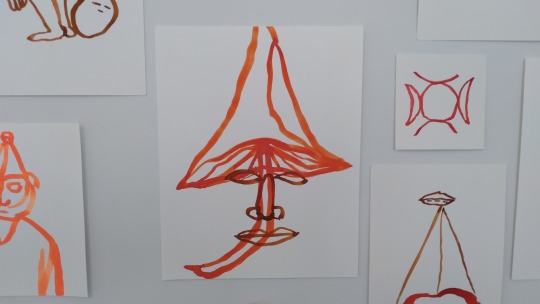



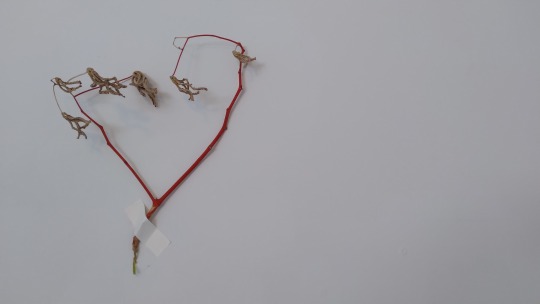
1 note
·
View note